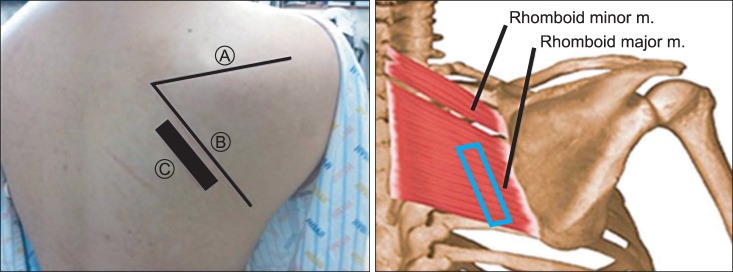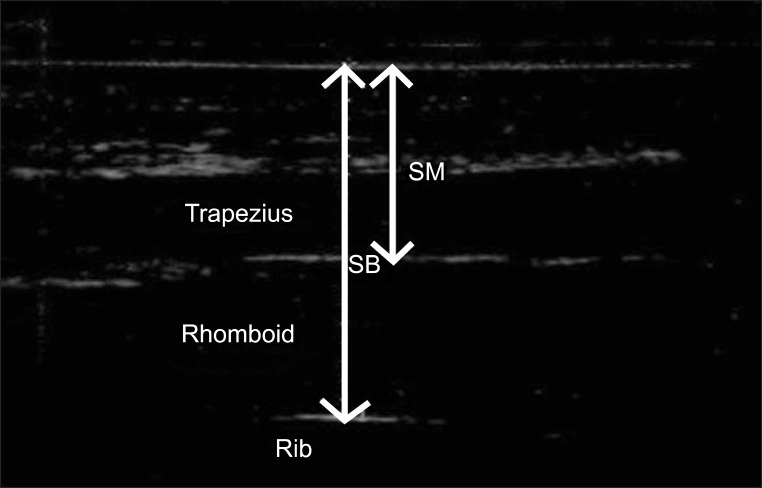Ann Rehabil Med.
2014 Feb;38(1):72-76. 10.5535/arm.2014.38.1.72.
Appropriate Depth of Needle Insertion During Rhomboid Major Trigger Point Block
- Affiliations
-
- 1Department of Rehabilitation Medicine, Hanyang University College of Medicine, Seoul, Korea.
- 2Department of Rehabilitation Medicine, Hanyang University Guri Hospital, Hanyang University College of Medicine, Guri, Korea. systole77@hanmail.net
- KMID: 2266543
- DOI: http://doi.org/10.5535/arm.2014.38.1.72
Abstract
OBJECTIVE
To investigate an appropriate depth of needle insertion during trigger point injection into the rhomboid major muscle.
METHODS
Sixty-two patients who visited our department with shoulder or upper back pain participated in this study. The distance between the skin and the rhomboid major muscle (SM) and the distance between the skin and rib (SB) were measured using ultrasonography. The subjects were divided into 3 groups according to BMI: BMI less than 23 kg/m2 (underweight or normal group); 23 kg/m2 or more to less than 25 kg/m2 (overweight group); and 25 kg/m2 or more (obese group). The mean+/-standard deviation (SD) of SM and SB of each group were calculated. A range between mean+1 SD of SM and the mean-1 SD of SB was defined as a safe margin.
RESULTS
The underweight or normal group's SM, SB, and the safe margin were 1.2+/-0.2, 2.1+/-0.4, and 1.4 to 1.7 cm, respectively. The overweight group's SM and SB were 1.4+/-0.2 and 2.4+/-0.9 cm, respectively. The safe margin could not be calculated for this group. The obese group's SM, SB, and the safe margin were 1.8+/-0.3, 2.7+/-0.5, and 2.1 to 2.2 cm, respectively.
CONCLUSION
This study will help us to set the standard depth of safe needle insertion into the rhomboid major muscle in an effective manner without causing any complications.
MeSH Terms
Figure
Cited by 1 articles
-
A Pair of Atypical Rhomboid Muscles
Jihyun Lee, Wonsug Jung
Korean J Phys Anthropol. 2015;28(4):247-251. doi: 10.11637/kjpa.2015.28.4.247.
Reference
-
1. Moon CW. Myofascial pain syndrome. J Korean Pain Soc. 2004; 17(Suppl):S36–S44.
Article2. Scott NA, Guo B, Barton PM, Gerwin RD. Trigger point injections for chronic non-malignant musculoskeletal pain: a systematic review. Pain Med. 2009; 10:54–69. PMID: 18992040.
Article3. Melzack R, Stillwell DM, Fox EJ. Trigger points and acupuncture points for pain: correlations and implications. Pain. 1977; 3:3–23. PMID: 69288.
Article4. Fitzgibbon DR, Posner KL, Domino KB, Caplan RA, Lee LA, Cheney FW. Chronic pain management: American Society of Anesthesiologists Closed Claims Project. Anesthesiology. 2004; 100:98–105. PMID: 14695730.5. Yang CS, Chen HC, Liang CC, Yu TY, Hung D, Tseng TC, et al. Sonographic measurements of the thickness of the soft tissues of the interscapular region in a population of normal young adults. J Clin Ultrasound. 2011; 39:78–82. PMID: 21213332.
Article6. Mohr M, Abrams E, Engel C, Long WB, Bottlang M. Geometry of human ribs pertinent to orthopedic chest-wall reconstruction. J Biomech. 2007; 40:1310–1317. PMID: 16831441.
Article7. Dupont AC, Sauerbrei EE, Fenton PV, Shragge PC, Loeb GE, Richmond FJ. Real-time sonography to estimate muscle thickness: comparison with MRI and CT. J Clin Ultrasound. 2001; 29:230–236. PMID: 11323778.
Article8. Watanabe K, Miyamoto K, Masuda T, Shimizu K. Use of ultrasonography to evaluate thickness of the erector spinae muscle in maximum flexion and extension of the lumbar spine. Spine (Phila Pa 1976). 2004; 29:1472–1477. PMID: 15223941.
Article9. Ceccherelli F, Rigoni MT, Gagliardi G, Ruzzante L. Comparison of superficial and deep acupuncture in the treatment of lumbar myofascial pain: a double-blind randomized controlled study. Clin J Pain. 2002; 18:149–153. PMID: 12048416.
Article10. Itoh K, Katsumi Y, Kitakoji H. Trigger point acupuncture treatment of chronic low back pain in elderly patients: a blinded RCT. Acupunct Med. 2004; 22:170–177. PMID: 15628774.
- Full Text Links
- Actions
-
Cited
- CITED
-
- Close
- Share
- Similar articles
-
- Interscalene brachial plexus block: depth and angle from the skin insertion point to the brachial plexus and to C6-7 intervertebral foramen
- Efficacy of rhomboid intercostal block for analgesia after thoracotomy
- Epidural and Psoas Abscesses Recognized after Paravertebral Trigger Point Injection: A case report
- The Effect of Tienchu Acupoint Block, Occipital Nerve Block, and Trigger Point Injection for Treatment of Tension Type Headache
- The Effect of Trigger Point Injection and C2-ganglion Block for the Patients with Chronic Headache




